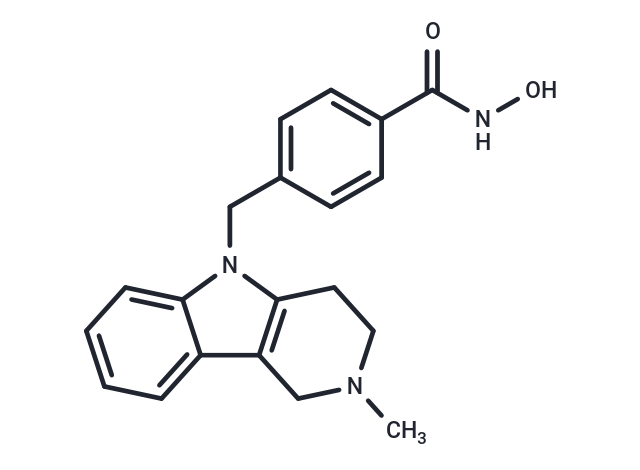Shopping Cart
- Remove All
 Your shopping cart is currently empty
Your shopping cart is currently empty

Tubastatin A (Tubastatin A BASE) is an effective and specific HDAC6 inhibitor (IC50: 15 nM, in a cell-free assay). Its selectivity is 1000-fold against all the other isozymes except HDAC8.

| Pack Size | Price | Availability | Quantity |
|---|---|---|---|
| 10 mg | $41 | In Stock | |
| 25 mg | $58 | In Stock | |
| 50 mg | $72 | In Stock | |
| 100 mg | $113 | In Stock | |
| 200 mg | $172 | In Stock | |
| 500 mg | $288 | In Stock | |
| 1 mL x 10 mM (in DMSO) | $39 | In Stock |
| Description | Tubastatin A (Tubastatin A BASE) is an effective and specific HDAC6 inhibitor (IC50: 15 nM, in a cell-free assay). Its selectivity is 1000-fold against all the other isozymes except HDAC8. |
| Targets&IC50 | HDAC6:15 nM |
| In vitro | Tubastatin A (5 μM) dose-dependently protected neuronal cells from homocysteine-induced death, which was completely avoided at 10 μM. Tubastatin A (10 μM) slightly induced histone acetylation. When applied to cholangiocarcinoma cell lines, Tubastatin A (10 μM) induced an increase in the level of acetylated α-tubulin and the restoration of primary cilia expression, which correlated with the down-regulation of Hedgehog and MAPK signaling pathways, and a decrease in the rate of cell proliferation (50% on average) and infiltration (40%). Tubastatin A significantly inhibited TNF-α and IL-6 when acting on lipopolysaccharide-stimulated human THP-1 macrophages (IC50: 272/712 nM). When acting on mouse Raw 264.7 macrophages, Tubastatin A dose-dependently inhibited nitric oxide secretion (IC50: 4.2 μM). |
| In vivo | Tubastatin A (5 μM) dose-dependently protected neuronal cells from homocysteine-induced death, which was completely avoided at 10 μM. Tubastatin A (10 μM) slightly induced histone acetylation. When applied to cholangiocarcinoma cell lines, Tubastatin A (10 μM) induced an increase in the level of acetylated α-tubulin and the restoration of primary cilia expression, which correlated with the down-regulation of Hedgehog and MAPK signaling pathways, and a decrease in the rate of cell proliferation (50% on average) and infiltration (40%). Tubastatin A significantly inhibited TNF-α and IL-6 when acting on lipopolysaccharide-stimulated human THP-1 macrophages (IC50: 272/712 nM). When acting on mouse Raw 264.7 macrophages, Tubastatin A dose-dependently inhibited nitric oxide secretion (IC50: 4.2 μM). |
| Kinase Assay | HDAC enzymatic assays: Tubastatin A is dissolved and diluted in assay buffer (50 mM HEPES, pH 7.4, 100 mM KCl, 0.001% Tween-20, 0.05% BSA, and 20 μM tris(2-carboxyethyl)phosphine) to 6-fold of the final concentration. HDAC enzymes are diluted to 1.5-fold of the final concentration in assay buffer and pre-incubated with Tubastatin A for 10 minutes before the addition of the substrate. The amount of FTS (HDAC1, HDAC2, HDAC3, and HDAC6) or MAZ-1675 (HDAC4, HDAC5, HDAC7, HDAC8, and HDAC9) used for each enzyme is equal to the Michaelis constant (Km), as determined by a titration curve. FTS or MAZ-1675 is diluted in assay buffer to 6-fold the final concentration with 0.3 μM sequencing grade trypsin. The substrate/trypsin mix is added to the enzyme/compound mix and the plate is shaken for 60 seconds and then placed into a SpectraMax M5 microtiter plate reader. The enzymatic reaction is monitored for release of 7-amino-4-methoxy-coumarin over 30 minutes, after deacetylation of the lysine side chain in the peptide substrate, and the linear rate of the reaction is calculated. |
| Cell Research | Anchorage-independent growth is assessed by growing cells in soft agar. About 25,000 cells suspended in 0.4% agar in culture media are layered over a 1% agar layer in a 6-well plate. Media are added twice a week and pictures are taken after 21 days of incubation. The number and size of colonies are analyzed using the Gel-Pro software.(Only for Reference) |
| Alias | Tubastatin A BASE |
| Molecular Weight | 335.4 |
| Formula | C20H21N3O2 |
| Cas No. | 1252003-15-8 |
| Smiles | CN1CCc2c(C1)c1ccccc1n2Cc1ccc(cc1)C(=O)NO |
| Relative Density. | 1.28 g/cm3 (Predicted) |
| Storage | Powder: -20°C for 3 years | In solvent: -80°C for 1 year | Shipping with blue ice. | |||||||||||||||||||||||||||||||||||
| Solubility Information | DMSO: 35 mg/mL (104.35 mM), Sonication is recommended. Ethanol: < 1 mg/mL (insoluble or slightly soluble) H2O: < 1 mg/mL (insoluble or slightly soluble) | |||||||||||||||||||||||||||||||||||
Solution Preparation Table | ||||||||||||||||||||||||||||||||||||
DMSO
| ||||||||||||||||||||||||||||||||||||

Copyright © 2015-2025 TargetMol Chemicals Inc. All Rights Reserved.